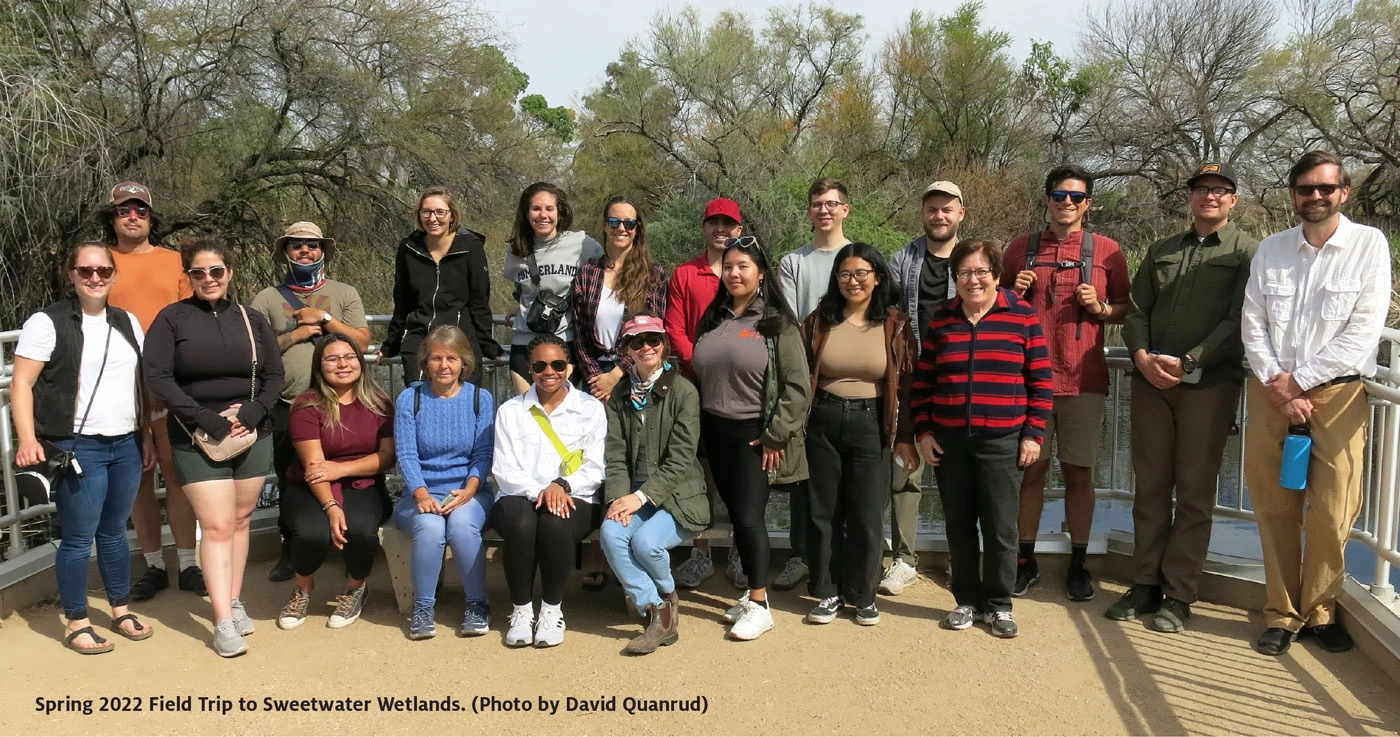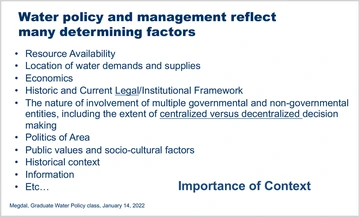
This Spring Semester I once again taught my graduate class, Water Policy in Arizona and Semi-arid Regions. Like last year, I had a good-sized seminar class, with 18 students, including two auditors. Unlike last year, we met in person, with virtual participation available for any student who could not attend class and for some guest speakers. Though it took some learning to deliver the class effectively in a hybrid setting, the dual platform for delivery enabled consistent participation throughout the semester. I do think this is the way future classes will be offered.
The three-unit class met Friday mornings for 2.5 hours. Because many people may wonder what a course in water policy is about, I share, here, the course expectations we go over at the first meeting.
Course Outcomes
- Interpret the role of regulation, institutions, and the legal framework for water allocation and use in determining the utilization of water across types of uses, geography, and time.
- Synthesize the complexities associated with developing and implementing water policies to address water challenges.
- Evaluate how policies and policy proposals meet public policy objectives.
Expected Student Outcomes
- Assess water policy and management challenges through class readings, discussions, and in-depth analysis of the research paper topic.
- Choose a water policy and/or water management strategy to serve as the subject of an individual research paper.
- Describe the context and appraise water management solutions through presentation and completion of the final paper on the selected paper topic.
- Explain your research paper findings and recommendations.

Also during the first class, I highlight the slide pictured. I regularly include this slide in presentations to diverse audiences. It enables me to underscore the importance of the many factors that determine water policy and management, especially those underlined. I also highlight the importance of context, especially that associated with the water cycle and geographic scale.
A key contributor to the student’s grade is the work connected to their policy research paper. One of the challenges for students to produce a policy-focused research paper by the end of the semester is that, for many, this course is their first in-depth exposure to water policy – and often their very first exposure. Each student must select a topic, write a paper abstract, make a presentation, and submit a 5,000-to-6,000-word paper – all within a single semester. I require students to interview at least three experts as part of their research; those interviews must be fit into the semester as well. I learn from the students’ papers, and the students learn from each other through the paper presentations, which are scheduled for the last two class meetings. Allowing time for 16 paper presentations, followed by Q&A, necessarily means that paper presentations are short. Presenting research topics and findings in 12 minutes is itself a challenging assignment. All did a great job!
Another key component of their grade is participation. I was very pleased with how engaged the students were throughout the semester. They took advantage of opportunities to ask thoughtful and informed questions of guest speakers, each other, and me. They walked with me to a meeting of the Ag 100, a group of leaders from Arizona’s agricultural sector, to observe a panel discussion of some of the water issues the agricultural community is facing. I observed several students networking with members of the Ag 100 during the break. Due to the pandemic, I did not schedule the traditional field trip to multiple water projects in the Tucson region, but most students were able to participate in an optional Saturday field trip to Tucson Water’s Sweetwater Wetlands. There we were joined by Dr. David Quanrud and a few of his students. Also joining us were two of my students from Spring 2021, when we were unable to meet in person for anything class related. At the following class, Tucson Water hydrologist Margaret Snyder joined us via Zoom to provide additional information and answer questions that neither Dr. Quanrud nor I could address. As can be seen from some of the photos, Sweetwater Wetlands is an excellent stop not only to learn about Tucson Water’s approach to water reuse, but also to observe the region’s plants, birds, and on that day, turtles!

I was truly energized throughout the semester by the students’ intellect and inquisitiveness. I find it noteworthy that many of their papers included recommendations for more efforts to educate the public on the water issues they researched. The students recognized that there is much to be learned about water policy and, importantly, much to be gained from sharing information and insights about water challenges and possible solutions through broad-based public participation. I am gratified that, through this course, I have added to the students’ understanding of water policy. Whatever their future careers, I hope they will reflect and draw upon this class to contribute to tackling the water challenges of Arizona and other semi-arid regions.

